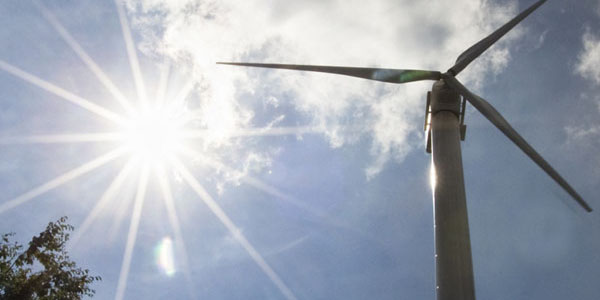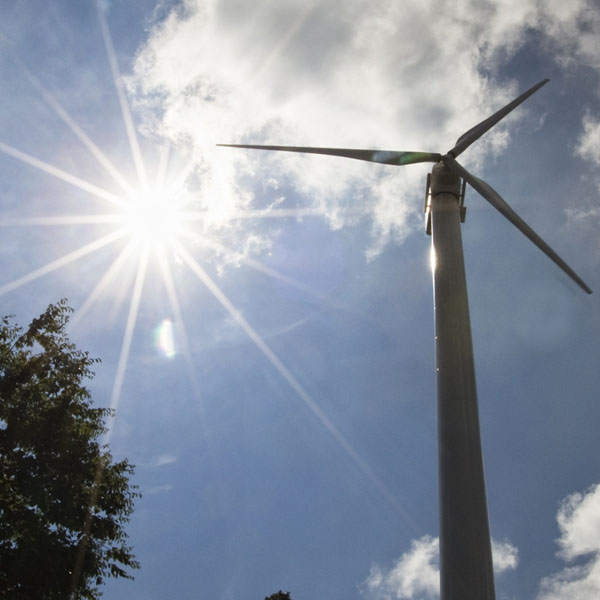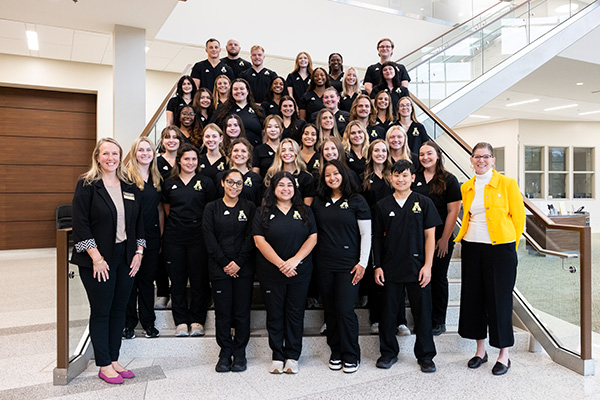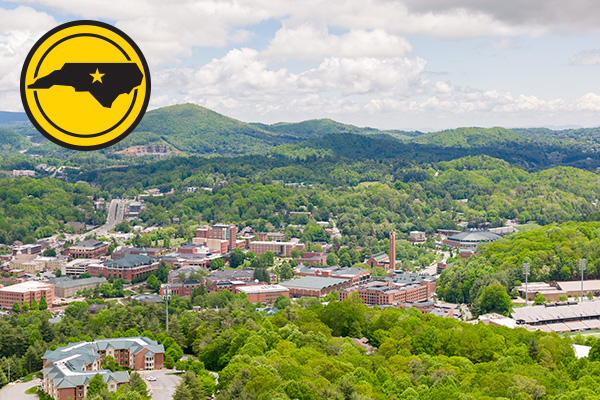BOONE, N.C. — Appalachian State University’s campus grew by 50 percent from 2002-17, yet, according to the university’s 2017 Strategic Energy and Water Management Policy, its energy usage intensity (EUI) reduced by 45 percent — the highest reduction among all schools in the University of North Carolina System.
Furthermore, the university has met three of four short-term sustainability goals for 2018-19 and is on track to achieve the 2050 goal of carbon neutrality set by the UNC System.
Patrick Richardson, energy analyst for Appalachian, and Jim Dees, data and assessment specialist in Appalachian’s Office of Sustainability, opened the Sustainable Energy Speaker Series in February on Appalachian’s campus by addressing the EUI reduction, along with the university’s water usage intensity reduction of 53 percent over the same period.
These reductions have allowed the university to avoid $37 million in energy and water costs, according to Richardson and Dees.
The effort behind this energy conservation, Dees said, “has been a collective effort of the entire university.”
What can such energy reductions accomplish? Richardson said in 2016-17 alone, Appalachian avoided using over 95 million British thermal units — enough energy to power 2,160 average North Carolina houses for the year or heat over 10,000 Olympic-size swimming pools to boiling. Appalachian also avoided using over 37 million gallons of water, which would fill 566 Olympic-size swimming pools or more than 8 million standard-size bathtubs.
Achieving goals through teamwork, leadership
Richardson and Dees attribute these energy achievements to both leadership and teamwork, citing several initiatives that are in place at Appalachian to meet energy sustainability goals:
- the Renewable Energy Initiative (REI);
- the Sustainability Council;
- the Office of Sustainability;
- Appalachian’s Campus Master Plan 20/20;
- Appalachian’s 2017 Strategic Energy and Water Management Plan (PDF 13.7M);
- the Board of Trustees’ commitment to LEED building standards; and
- the Research Institute for Environment, Energy, and Economics (RIEEE), among others.
“Thanks to the ASUREI, we have one of the most diverse energy usage portfolio in the state,” Richardson said. ASUREI, a student-led, student-funded organization at Appalachian, installs renewable energy and energy efficiency projects on campus.
Additionally, many different strategies were used to achieve the 45 percent EUI reduction, they said, including infrastructure efforts made by Appalachian’s Physical Plant — optimizing HVAC systems, installing occupancy controls, implementing LED lighting, tracking energy performance and setting goals, and utilizing performance contracting.
Performance contracting, according to the North Carolina Department of Environmental Quality (DEQ), “is a method of financing, designing and building major projects that have a return on investment in avoided utility costs. It provides a way to replace obsolete and inefficient equipment using guaranteed utility savings to pay for the project.” Last year, the university received a $448,000 return from its performance contract through North Carolina DEQ’s Utility Savings Initiative (USI) program to invest in other energy-saving initiatives.
Dees said a “culture change” also took place at the state level through enacted legislative changes — such as State of North Carolina executive order No. 156 (PDF 53K) in 1999 and the North Carolina Senate Bill 668 in 2007 — which were then incorporated into practices across the UNC System.
In 2009, the UNC System created its Sustainability Policy, which details the systemic integration of sustainability principles and sets a 2050 goal of carbon neutrality — with the ultimate goal of becoming climate neutral — for all schools in the system.
Carbon neutrality — current status
According to Appalachian’s Strategic Energy and Water Management Policy, the university is on track to meet the 2050 carbon neutrality target. Appalachian uses metric tons of equivalent carbon dioxide (MTeCO2) as the units of measurement with which to gauge its level of progress toward climate neutrality, or having a net-zero carbon footprint.
However, Dees said 40 percent of the university’s carbon emissions come from transportation and this “transportation footprint” has been difficult to reduce. The footprint includes diesel fuel used by AppalCart; overseas travel of students and faculty through study abroad programs; travel to and from games for Appalachian athletic teams; travel to and from conferences attended by Appalachian faculty and staff; and the daily commute of students, faculty and staff to and from Appalachian.
Richardson and Dees said a transportation survey will be offered to faculty, staff and students later this semester to help the university set future goals for decreasing transportation emissions. The survey will collect data from the Appalachian Community regarding how many miles an individual lives from campus; the type of vehicle one drives; the method one chooses for commuting (driving, bicycling, walking, etc.); and how often one commutes to and from the university.
Recommended short-term strategies for reducing transportation emissions, according to the Strategic Energy and Water Management Policy, include continued purchasing of long-distance fleet vehicles that are flex fuel capable, as well as purchasing electric vehicles for local use. Possible long-term strategies include providing charging stations on campus for university vehicles as well as E85 and biodiesel at campus refueling stations, and shifting toward purchasing vehicles that use electric, biodiesel and E85 fuels.
Currently, the university has met and exceeded three of four short-term sustainability goals as outlined in its strategic plan, “The Appalachian Experience: Envisioning a Just and Sustainable Future,” which was created in 2014. These goals are for greenhouse gas emissions, energy consumption and water usage.
The fourth goal — 0.5 percent of Appalachian’s total consumed energy generated from university-owned renewable energy systems by 2018-19 — has yet to be achieved, said Richardson and Dees. In 2016-17, Appalachian achieved 0.15 percent of its total consumed energy from such systems.
Short- and long-term renewable energy projects
All current, short-term projects for reaching the renewable energy utilization goal, which are detailed in the Strategic Energy and Water Management Policy, involve updating existing or installing new photovoltaic (PV) systems on Appalachian buildings.
“In cooperation between Appalachian’s REI, the Sustainability Office, the Physical Plant and University Housing, we have repaired three broken solar thermal systems over the past year in Mountaineer (Hall), Summit (Hall) and the (Reich) College of Education,” Richardson said. “These repairs and additions will now make 0.27 percent of Appalachian’s energy sourced by on-campus renewable sources.”
Appalachian’s REI has funded a 57-kW PV system for the new Beaver College of Health Sciences facility that is scheduled to be complete for the 2018-19 academic year. Other projects under consideration include the replacement of Frank Hall’s current solar thermal system with a 37-kW PV system through Appalachian’s REI.
“Another big development,” Richardson said, “is the implementation of energy system monitoring by the Data Management Committee of Appalachian’s REI, allowing us to identify problems quickly. Interested parties can see what our systems are producing in the ASUREI Kiosk in Plemmons Student Union or on the ASUREI energy dashboard.”
Long-term strategies to help achieve Appalachian’s energy utilization goal include transitioning to the purchase of 100 percent renewable energy sources that do not use fossil or nuclear fuels. This development is under review by Appalachian’s New River Light and Power Co. and could reduce the university’s carbon footprint by 33 percent, Dees said.
“It is hoped that the new strategic plans will motivate Appalachian to make our new and remodeled buildings significantly more energy efficient in order to meet Appalachian and the UNC System’s commitment to net-zero energy use by 2050,” Richardson said.
About Sustainability and Energy Management at App State
Appalachian State University’s leadership in sustainability is known nationally. The university’s holistic, three-branched approach considers sustainability economically, environmentally and equitably in relationship to the planet’s co-inhabitants. The university is an active steward of the state’s interconnected financial, cultural and natural resources and challenges students and others think critically and creatively about sustainability and what it means from the smallest individual action to the most broad-based applications. The university offers both undergraduate and graduate academic degree programs that focus on sustainability. In addition, 100 percent of Appalachian’s academic departments offer at least one sustainability course or course that includes sustainability, and all students graduate from programs that have adopted at least one sustainability learning outcome. Learn more at https://appstate.edu/sustainability.
About the Appalachian Energy Center
The Appalachian Energy Center (AEC) at Appalachian State University conducts energy research and applied program activities in the areas of energy efficiency, renewable energy technologies, forecasting and modeling, economic development and policy analysis in a multidisciplinary environment that leverages the expertise of faculty, staff and students from across the university as a resource for private industry, local, state and federal governments, as well as nonprofits. Through its outreach programs and research, the Appalachian Energy Center benefits communities and citizens across the state by helping create new jobs, businesses and increased investment and income. Learn more at https://energy.appstate.edu.
About the Department of Sustainable Technology and the Built Environment
One of seven departments housed in the College of Fine and Applied Arts, the Department of Sustainable Technology and the Built Environment at Appalachian State University features an integrated array of programs spanning the fields of sustainable design and technology. Its mission is to foster a strong and vibrant culture of inquiry, discovery and innovation that integrates theory with application, problem seeking with problem-solving, local issues with global perspectives and technological progress with environmental stewardship. It offers bachelor’s degrees in sustainable technology and building science, and a master’s degree in technology. Learn more at https://stbe.appstate.edu.
About Appalachian State University
As a premier public institution, Appalachian State University prepares students to lead purposeful lives. App State is one of 17 campuses in the University of North Carolina System, with a national reputation for innovative teaching and opening access to a high-quality, cost-effective education. The university enrolls more than 21,000 students, has a low student-to-faculty ratio and offers more than 150 undergraduate and 80 graduate majors at its Boone and Hickory campuses and through App State Online. Learn more at https://www.appstate.edu.
What do you think?
Share your feedback on this story.

















